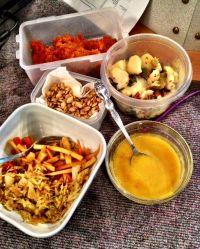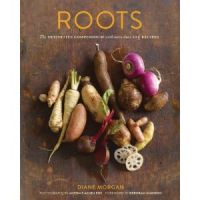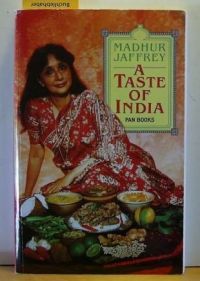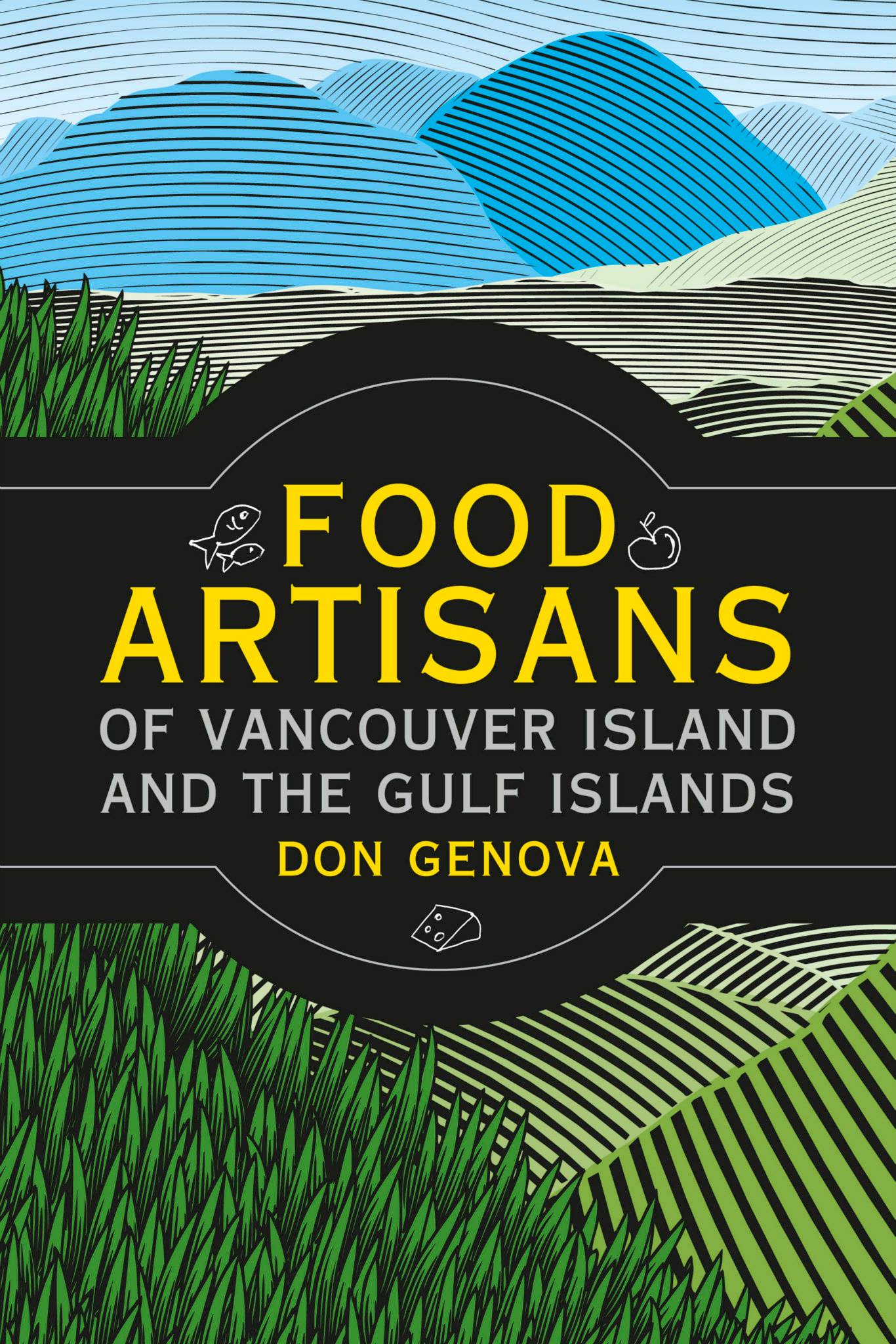Halloween is just around the corner, and with that comes all kinds of pumpkins, mostly used for carving and propping up at your front door, and then discarded. Today on Food Matters on CBC Victoria’s All Points West program, I discussed ways to avoid wasting an edible food product, and some tips on saving money with other seasonal, local vegetables.
I grew up in a pumpkin patch. Well, not right in the patch, but we had an acre of land and my dad grew pumpkins on about a third of that acre. In the fall I would load up our little trailer and drive it with our garden tractor to the end of our driveway and sell pumpkins to passing drivers on their way to or from work. 25 dents for a small one, 50 cents for a large one, and some of them were very large! The funny thing is that I grew up only liking pumpkin pie and hating any other kind of squash or pumpkin dishes.
Now I’m a huge fan of squash soups that are well-spiced, and when I was living in Italy one of the specialities of the region I lived in was something called tortelli di zucca, a ravioli-style pasta stuffed with cooked pumpkin and flavoured with amaretti cookies and drenched in a sage-butter sauce. Who wouldn’t like that? But are the Italian pumpkins the same as our big orange pumpkins here? No. Those Italian pumpkins taste better. And this is where I’m going to make a radical suggestion. If you want to get more food value out of your Halloween pumpkin, look for something a little different. Farmers are growing all kinds of different pumpkins now, and many of them are tastier to eat than a Halloween pumpkin. Ask them which ones they think are better for cooking. Then don’t carve them. Make a display out of a bunch of them, or just decorate them on the outside. Then they are still perfectly good for eating, you don’t have to scrape out the old candle wax and burnt parts. And save those seeds! Today I roasted some with just a little bit of grapeseed oil and a sprinkle of lime chili salt from Organic Fair.
I also brought Jo-Ann some butternut squash soup, flavoured with garam masala, a single tiny hot pepper and finished with coconut milk. Some of these pumpkins or squashes are quite large and thick-skinned, sometimes hard to cut them apart without losing a finger! But I just picked up this tip from chef Brock Windsor at the Stone Soup Inn. Take your squash or pumpkin outside and just drop it on the sidewalk or driveway. It will crack open and make it easier for you to cut into smaller pieces. And instead of taking a lot of time to peel the hard skin off, just put those pieces skin on in your oven and roast the pumpkin instead of boiling it. You can add some olive oil, salt and pepper, and roast at 400 degrees F. until it is nice and fork tender. Then it comes off the skin so much more easily and you’ve added more flavour to it. For more on pumpkin varieties and which ones are good to eat, check out this post on the (ex)Expatriate’s Kitchen blog.
Also on my mind this week: results are coming in from the 26 Dollar Challenge, as BC politicians and other notable citizens were asked to feed themselves on just 26 dollars for a whole week. The challenge was issued by Raise the Rates, a poverty advocacy group based in Vancouver that figures once people on welfare pay for everything else they need from their 610 dollars a month, they are left with just 26 dollars a week for food. I didn’t do the challenge myself, but I gave it some thought and a visit to a local supermarket the other day gave me some ideas. The store had big bags of BC carrots, potatoes, parsnips, beets, onions and cabbage on for some really good prices and I stocked up…since these can be the basics of either great side dishes or the star of a meal themselves.
Such as: – Parsnips (and a few carrots) braised in orange juice and caramelized with some butter, sugar and cumin.
– Cabbage and onions cooked with just half a bottle of beer (you could use just water or chicken stock) flavoured with some Tannadice Farms pork sausage and caraway seed.
– Potato salad with onion and a little bacon for flavouring.
– Carrot halvah. This is a dessert.
I got a great new cookbook recently called Roots, 225 recipes from Diane Morgan of Portland, Oregon, that’s where the parsnip and potato salad recipe came from.
So there are just a few ways to cook cheaply, still using local ingredients and in a good variety of flavours.
Here’s my recipe for the braised cabbage that everyone at the CBC office seemed to like today!
BRAISED CABBAGE WITH BEER, SAUSAGE AND CARAWAY
Ingredients:
1 tsp butter
1 tsp olive oil
1 onion, peeled and sliced
3 cloves of garlic, peeled and coarsely chopped
1/2 pound precooked sausage, Polish kielbasa for example, cut into 1/2 inch rounds
1 small head of green cabbage halved, cored and sliced
1/2 bottle of your favourite beer (drink the other half!) or chicken stock or even water
1 tsp sugar
1 tsp caraway seeds
salt and pepper to taste
Melt the butter and olive oil together in a large fry pan over moderate heat. Add the onion, stir and fry until it turns translucent, and then add the garlic cloves, stir for 1-2 minutes. Add the sausage, stir and then the cabbage. Toss it all around so the cabbage starts to wilt a bit and gets covered with the butter/oil combination. Add the sugar and the beer or stock, along with the salt and pepper to taste. Cover and simmer until the cabbage is just tender. Add the caraway seeds at the end of cooking and check your seasoning. Enjoy!
And here is the Carrot Halva recipe, it’s a little time consuming to make, but I think it’s worth it!
Carrot Halva – From “A Taste of India” by Madhur Jaffrey
6 medium carrots
3 cups milk
8 whole cardamom pods
6 TBS vegetable oil or Ghee (clarified butter)
6 TBS sugar
1-2 TBS golden raisins
1 TBS shelled unsalted pistachios, lightly crushed
1 1/4 cups heay cream, lightly whipped (optional)
Peel and grate the carrots. Put the grated carrots, milk and cardmom pods in
a heavy bottomed pot, and bring to a boil. Turn heat to medium and cook,
stirring now and then, until there is no liquid left. Adjust the heat if you
need to.
Heat the oil/ghee in a nonstick frying pan over a medium-low flame. When
hot, put in the carrot mixture. Stir and fry until the carrots no longer
have a wet, milky look. They should turn a rich reddish color. This can
take 10 – 15 minutes.
Add the sugar, raisins and pistachios. Stir and fry for another 2 minutes.
This halva may be served warm or at room temperature. Serve cream on the
side.







